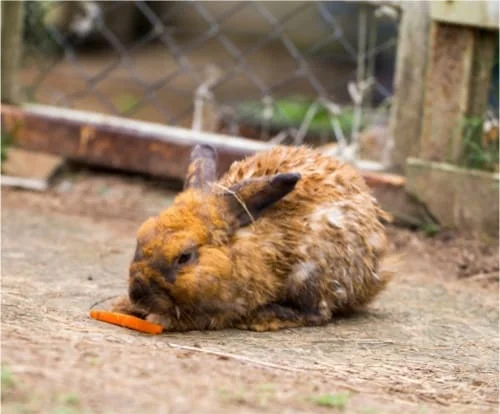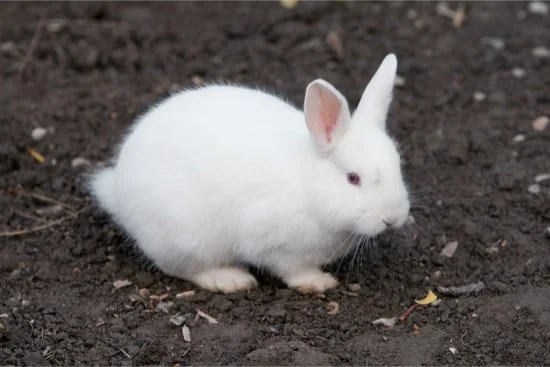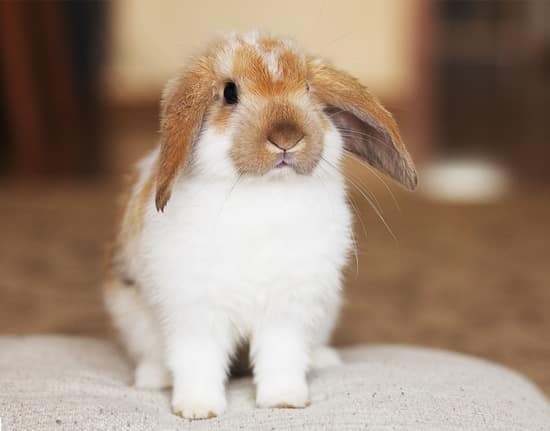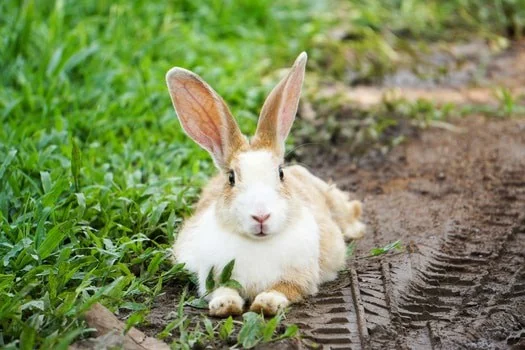A rabbit’s tail and hindquarters must always be dry. If your rabbit is damp around the rear, they are experiencing difficulty urinating. A strong smell of ammonia also denotes health issues. These are warning signs that your rabbit is urinating on their own skin, which can lead to scalding.
If your rabbit has urine scalding, apply Sudocrem to any inflamed skin. Assess why the scalding occurred. Limited mobility is often to blame, but your rabbit may have a urinary tract infection (UTI).
Urine scalding in rabbits is dangerous, but manageable. Be aware that it is a symptom and not a disease. If your rabbit has an infection, this must be addressed. Likewise, they may need a change in diet or lifestyle. This guide will help you understand what is causing your rabbit’s urinary issues.
What is Wet Tail in Rabbits?
If your rabbit is having trouble eliminating, urine will sink into their fur. As the urethra of a rabbit is located at their hindquarters, this will often lead to a wet tail.
It doesn’t stop here, though. Urine will dribble down a rabbit’s hind legs, and stain their fur yellow. This isn’t just unsightly and potentially smelly. It’s hazardous to a rabbit’s health.
Urine scald causes a rabbit’s fur to fall out. It also leaves a bunny’s skin sore. Eventually, this skin will break and leave your rabbit open to infection. The most significant risk here is Flystrike, which is a fatal condition for rabbits.
Wet tail and urine scalding are symptoms of a wider problem. Just washing your rabbit is not sufficient treatment. You’ll need to get to the root to the issue, and resolve it.
What Are the Symptoms of Wet Tail in Rabbits?
Depending on how severe the urine scalding is, your rabbit’s tail will be damp or soaking wet. Neither of these conditions are healthy for a bunny to live with. They should be dry at all times.
There many ways that urine scald impacts your rabbit. Symptoms include:
- Clear and visible urine stains on the hind legs
- A strong smell of ammonia following your rabbit
- Bald patches and missing fur around the back legs
- Red skin and open wounds down the rear legs
- Whimpering, squealing and other vocalizations of pain while urinating
- Loss of appetite
If you spot any of these issues, you’ll need to take action. Your bunny is uncomfortable, and in danger of severe health complications.
What Are the Causes of Wet Tail in Rabbits?
There is a range of possible explanations for urine scalding in rabbits. These may be medical or lifestyle-related. Among the most common reasons for urine scolding are:
- Obesity
- Arthritis
- Urinary tract infections
- Injury or paralysis to the back legs
- Encephalitozoon Cuniculi (aka e. cuniculi)
- Complications following neutering
Urine scalding may also be a result of unsanitary living conditions. A rabbit should always be litter trained. This prevents them from lying in their own waste. Also, change the hay in their hutch daily.
Even if you do train your bunny to use a litter tray, they may use it as a bed. This means that you’ll need to be vigilant about changing their litter regularly.
Obesity
An obese rabbit will have several folds and flaps of skin. They will not be equipped to deal with this problem. Rabbits in the wild do not have the luxury of growing overweight.
When your rabbit urinates, this excess skin will get in the way. Urine applied straight to a rabbit’s skin will scald. Also, urine can become trapped in these skin folds. It will then dribble down your rabbit’s legs and into their tail.
If your rabbit is overweight, you’ll need to review their diet. Minimize their intake of pellets and vegetables. Instead, offer unlimited fresh timothy hay.
Your bunny will still be content to munch on hay. They will be placing considerably fewer calories into their body, though. This, coupled with an exercise regime, will reduce their weight.
Arthritis and Joint Pain
Urinating rabbits position themselves to spray backward, away from their tail. If they have arthritis, they lack the flexibility to do this. They will not be able to get their legs out of the way.
Try giving your rabbit’s hind legs a massage. This will loosen up their muscles, and make movement easier. As a result, they’ll be able to move their legs easier.
Supplements will also ease the pain and discomfort associated with arthritis. This will restore flexibility to your rabbit. If they can get their legs out of the way of urine, they won’t be scalded.
Urinary Tract Infections
Your rabbit may have crystals in their urethra, making urination painful and difficult. This means that their pee will dribble and seep out, and roll down the leg. A UTI will be painful and upsetting, so seek treatment. The symptoms of urinary tract infections in rabbits include:
- Discolored urine. Rabbit pee should never be brown.
- Blood in the urine.
- Constant, small urination outside the litter tray.
- Visible pain and distress while urinating.
UTIs in bunnies are common once they reach middle age. Stress aggravates these infections, though. Keep your rabbit calm and happy.
You must also clean their hutch regularly, and provide a balanced diet. Excessive calcium can often lead to a rabbit UTI.

Injury or Trauma
If your rabbit has undergone severe trauma, they may lose flexibility in their hind legs. This means that they’ll struggle to move them while urinating. If your rabbit has a splayed leg, the result may be the same.
If it’s a pain that’s preventing your rabbit from moving their leg, this can be managed. If they have a splayed leg, it can be braced. This will help your bunny live a healthy life.
A loss of motor function is tougher to work around. If your rabbit cannot move their leg independently, you may have a tough decision to make. Constant urine scalding on the same leg will be painful, and very dangerous.
One solution could be to wrap your rabbit’s leg. A bandage, or similar, will protect the skin.
This bandage will need to be changed every time your rabbit eliminates, though. If your bunny is alone for any prolonged period, this technique is unsuitable.
e. Cuniculi
e. Cuniculi is a parasite that is found in rabbit urine. If a bunny inhales or licks the spores of this parasite, they can become infected. This leads to complications surrounding the brain and spine.
Only around 6% of rabbits react to e. Cuniculi. Unfortunately, these reactions are severe. Your bunny could lose feeling in one or both of their hind legs.
This will leave your bunny paralyzed. They will drag their leg or legs behind them. This, of course, means they cannot move them out of the way while urinating.
Steroids and anti-inflammatories may help. It depends how far along the condition is. The sooner you take action, the better your pet’s prognosis is.
Neutering Complications
This is rare, but it does happen. Neutering a male rabbit is a delicate procedure. Only a surgeon with considerable experience in handling these animals should attempt it.
Sometimes, the urethra of a neutered rabbit is exceptionally tight. This should be akin to a small tube. If there are surgical complications, it constricts to the size of the eye of a needle.
This makes urination difficult for the rabbit. Instead of the stream that would ordinarily occur, urine dribbles out slowly and awkwardly. This will then trickle down the hind legs of the rabbit. Swollen genitals are also possible.
Thankfully, this issue can be rectified. The rabbit’s urethral opening will need to be stretched. This is a relatively fast procedure for an experienced vet.
Why Does Wet Tail Need to be Treated?
Sometimes, there will be little that you can do to prevent urine scald. In the case of hind leg paralysis, your rabbit will always have difficulty avoiding it. You can take lifestyle steps to minimize the risk, though.
It must also be noted that just cleaning up your rabbit’s urine scald is not enough. Your rabbit has a problem that must be resolved. Failing to do so can lead to a range of health concerns. Also, constant urine scald is painful.
Urine scald must never be ignored. The longer the issue continues, the more likely a rabbit is to develop Flystrike. This is a potentially fatal disease in rabbits.

What is Flystrike and Why is it So Dangerous?
Flystrike occurs when houseflies start to circle your rabbit. They will be attracted to the scent of your bunny’s urine and feces. This is why regular cleaning and maintenance of a hutch is so critical.
A rabbit that endures prolonged urine scalding will develop open sores. These sores are the perfect place for a fly to lay their eggs. These eggs will then hatch as maggots within hours.
Maggots feast on dead flesh, so they’ll start to eat the necrotic skin. This will run out before too long, though. They’ll then begin to eat the healthy skin. Flystrike means that your rabbit is eaten alive, from the inside out.
If you see any flies in your rabbit’s hutch, they must be cleared out immediately. Assess your rabbit. If they have open wounds, they are at clear risk of Flystrike. Do not wash your rabbit, in such an instance. Get them straight to a vet.
A vet that is experienced in rabbit care will know how to help your bunny. They need to remove any maggots from their skin, using tweezers. An amateur should not attempt this, as a sedative will be required first.
Once the maggot infestation is treated, your rabbit’s wounds will be bandaged. Antibiotics will be prescribed, and possibly painkillers.
Treatment of Wet Tail in Rabbits
The most important thing is treating the immediate impact of urine scald. This will relieve your rabbit’s pain, at least in the short term. You must then learn what is causing the problem.
You may need expert help for the latter. A vet will run tests to determine the cause of urine scalding. If medication is required, this will be prescribed. This may take the form of antibiotics for a UTI.
You may be able to make some changes to your rabbit’s lifestyle. Consider altering their diet. Remove pellets, and increase hay. The fiber is essential for healthy digestion and bladder control.
Wet Tail Treatment at Home
If your rabbit has inflamed skin, rub a little Sudocrem on the impacted area. This over-the-counter product is rabbit-safe. It will help heal your bunny’s sore skin.
This doesn’t solve the problem of why your rabbit is struggling to urinate, though. This can be a process of elimination.
Look at the size of your rabbit’s hutch. Bunnies grow quickly, and it’s easy to underestimate how big they get. Is your rabbit’s hutch the appropriate size?
If your rabbit doesn’t have enough room, they’ll be exposed to their own urine. This will naturally lead to scalding. It’s time to upgrade your pet’s home.
Mother Earth Living offers some suggestions for aiding urinary infections. Echinacea is a natural antibiotic. Dandelion root will keep your bunny regular. Goldenseal, Oregon grape root and uva ursi all combat bladder infections.
How to Clean Urine Scald in Rabbits
If you notice urine scald on your rabbit’s fur, it will need to be cleaned up. There are two ways to do this, wet and dry. To clean up your rabbit without a bath, follow these steps:
- Ensure that your rabbit is calm and comfortable.
- Take some dry cornstarch, and rub this liberally to their damp legs. You’ll have to be gentle here. Urine scald is painful to rabbits, and they’ll likely resist being touched.
- Gently hold your rabbit in place, and keep them calm. They need to sit still while the cornstarch sinks into their fur.
- After a minute or two, the cornstarch will absorb the dampness.
- Brush and groom your rabbit, and let them free.
This technique does work, to an extent. You’ll still need to learn why your rabbit has urine scald. Fixing the symptom is not a cure.

In cases of stubborn urine scald, you’ll need to bath your rabbit. This shouldn’t take place more than once a week. Many bunnies find bath time stressful. It’s better than living with urine scald, though. To bathe a rabbit, follow these procedures:
- Fill a basin or sink with around 3 inches of warm water. This should not be too hot. Rabbit skin is delicate, and burns easily.
- Mix in some rabbit-friendly shampoo. This must be specially designed for a rabbit’s skin pH.
- Scoop up your rabbit. Hold them close to you, but not so tight that they’ll hurt themselves trying to escape.
- Supporting your rabbit’s hindquarters, gently lower them into the water. This water should not be higher than its hind legs. Never fully submerge a rabbit in water.
- Massage the shampoo into the scaled fur, and wash it off. Empty and refill the water at least once during this process. You don’t want to massage urine back into your pet’s fur.
- Once you’re satisfied that your rabbit is clean, dry them off with a thick, soft and fluffy towel.
- Take your rabbit’s temperature. If it’s between 101-103 degrees Fahrenheit, they’re free to go. If not, warm them up to this level before releasing them.
These techniques will remove the urine stains from your bunny’s fur. This will make them comfortable, and keep them safe for a short time.
Please allow us to stress one last time, though. Cleaning urine scald is not the same as treating urine scald. You must deal with the root issue.
Should I Amputate My Rabbit’s Tail to Resolve Wet Tail?
This is not helpful. A rabbit with no tail will still have the same health problems. You are not addressing their illness.
The wetness of their tail is a symptom, not a cause. Urine scalding must be resolved through medicine and lifestyle changes. Mutilating your bunny will add stress, and worsen their condition.
How Can Wet Tail in Rabbits be Prevented?
No treatment is preferable to preventing urine scalding in the first place. Do whatever you can to keep them ailments at bay.
Many rabbits past middle age will struggle with urine scald at one time or another, though. Take steps to delay the inevitable. These include:
- An appropriate hutch. If your rabbit’s hutch is too small, the risk of Wet Tail is magnified. Your bunny needs space to move.
- Litter training. If you litter train your rabbit, they’ll keep their eliminations to one particular area. This prevents them from spending too much time in their own waste. Urine scalding is thus less likely.
- Comfortable bedding. Some rabbits lay in their litter tray, as it’s soft and comfortable. Making their sleeping area just as appealing is essential. Learn what your rabbit likes to sleep on.
- Constant cleaning. An unsanitary hutch is a constant health risk for rabbits. Clean it in full at least once a week. Change litter and bedding every other day.
- A proper diet and regular exercise. A rabbit that sustains a healthy weight is less likely to experience urine scald. Ensure that your bunny eats well, and burns calories.
- Grooming. Your rabbit will do an excellent job of taking care of their own cleaning. They’ll never reject a helping hand, though. Grooming is also a great way to spot any issues with their fur.
- Regular veterinarian check-ups. Finding a rabbit savvy-vet is a must. Take your bunny for an annual nose-to-tail once-over.
- Recognizing the symptoms. Learn the warning signs of a UTI in your rabbit. If you treat the cause quickly, urine scald will not be an issue.
While urine scald is common, it’s not, “just one of those things.” Your rabbit should not be expected to live with this painful and dangerous condition.
Rabbit tails are not supposed to be wet. If you find that your pet’s rump is damp, it merits further investigation.
If you find yourself smelling ammonia, it’s another alarm bell. Rabbits are fastidious groomers. If they’re starting to smell bad, they’re struggling to meet their standards of cleanliness.
Urine scalding does not have to be problematic. It will become so if you ignore it, though. Keep on top of your rabbit’s hygiene. In doing so, you’ll also keep them healthy.


hi, I think my rabbit has UTI he does not eat his food or even play anymore he is so sad. I can’t bring him to the vet because my dad is not bringing me
My rabbit has urine scalding because she has lost the function in her hind legs. We bathe her every day and change her incontinence blanket three times a day, but unfortunately, in her situation we can only treat the urine scalding and not its cause. We have done absolutely everything we can to diagnose and treat, but she is sadly not going to recover the use of her legs, so we can only make her as comfortable as possible.